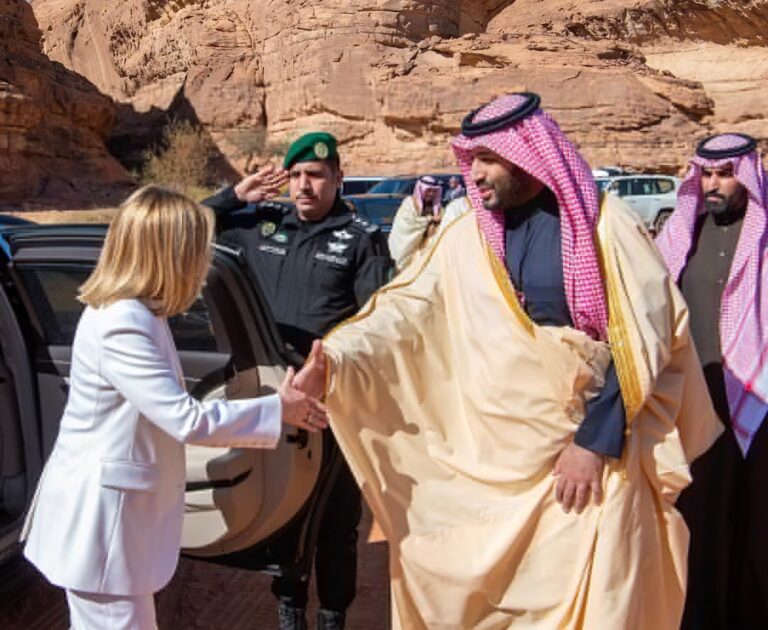Italian Prime Minister Giorgia Meloni has made public her position on Saudi Arabia’s potential entry into the Global Air Combat Program (GCAP), a sixth-generation fighter jet being jointly developed by Italy, Japan and the United Kingdom. Cleared.
Launched in 2022, GCAP is a joint initiative to design, manufacture and deliver the next generation of aircrewed combat aircraft.
Member countries of the GCAP group aim to introduce the first aircraft developed under this program by 2035. Mitsubishi Heavy Industries of Japan, Leonardo of Italy and BAE Systems of the UK are leading the project as system integrators.
On the question of whether the group would welcome Saudi entry, Meloni said: “We support entering Saudi Arabia, but obviously this is not immediate.” between the three founding countries. The Italian prime minister further added that opening up the multi-billion euro scheme to four countries would take time without giving an interim deadline.
Previously, Italian Foreign Minister Antonio Tajani said in November 2024 that the GCAP partnership is likely to be extended to Saudi Arabia in the future. However, this may be the first time that the head of a European country has declared her position on this issue.
In particular, just one week after Rome ratified the Global Combat Aviation Program (GCAP) treaty, the possibility of opening the sixth generation aircraft program to additional members in November 2024 was officially discussed .
At the time, British Prime Minister Keir Starmer highlighted the trio’s “ambition to expand our participation with a wider range of international partners in the future”. Details regarding potential participants were not disclosed, but Saudi Arabia was considered a potential candidate due to its sustained interest in GCAP.
Saudi Arabia announced early participation in the program in March 2023. This is a claim that was later retracted. However, reports suggest that discussions regarding Riyadh’s participation in GCAP have continued between Riyadh and GCAP members ever since.
Saudi Arabia’s interest in GCAP stems from a glaring gap in its fighter fleet. The kingdom wanted to acquire Lockheed Martin F-35 Lightning II stealth aircraft from the United States.
But the Pentagon remains hamstrung, largely due to a long-standing agreement with Israel that requires it to supply equipment with “superior capabilities” compared to that sold to Israel’s neighbors. I kept dragging it.
The kingdom is currently considering alternatives such as Turkey’s fifth-generation aircraft Kaan, but Riyadh is also keen to join a sixth-generation aircraft program to stay ahead of future rivals.
That said, Saudi Arabia’s entry into GCAP is dependent on the unanimous approval of all three founding members. Britain and Italy have indicated they will cooperate with Saudi Arabia, but Japan is hesitant. According to reports, two main reasons have been flagged internally by Japan. Export restrictions that may be necessitated by Saudi entry and potential delays in the program.

Saudi Arabia may have more hurdles. There have long been concerns about Saudi Arabia’s patchy human rights record, including civilian deaths as a result of its involvement in Yemen’s civil war. While Italy and the UK seem to have seen past these issues, Japan appears to have reservations. Additionally, Saudi Arabia’s close ties with China could also emerge as a potential deal-breaker.
There are reports that Saudi Arabia could join the program as a junior partner. This is a condition unacceptable to the kingdom. Saudi Arabia insists that no defense deal can be completed without incorporating domestic development and production. The Kingdom envisions contributing to the GCAP through manufacturing, technological advances, and skilled human capital.
Saudi officials are quoted as saying that their participation must be inclusive and meaningful, saying, “Otherwise it doesn’t mean anything to us.”
Saudi Arabia’s cash-rich kingdom brings significant financial support to the program. Given the expected next-generation capabilities, GCAP development comes with a hefty price tag, as seen in the NGAD 6th generation program.
Therefore, reducing costs by accessing Saudi cash can be very beneficial. It has the potential to accelerate aircraft construction and reduce the impact on GCAP members’ already tight defense budgets.
The Italian prime minister’s statement that it will take time suggests that the three founding members are far from reaching a consensus.
GCAP to be operational by 2035
Meloni’s statement also comes days after the British Parliament urged the country to expedite the program and avoid repeating the mistakes made during the development of the Eurofighter type.
Fighter jets developed under GCAP are uncertain, as America’s sixth-generation program, Next Generation Air Dominance (NGAD), is uncertain, with France-Germany—Spain now the first Western It is expected to be a generation aircraft. The Future Combat Air System (FCAS) is facing delays.
Last July, at the Farnborough International Air Show, three GCAP partner countries unveiled new conceptual models of future fighter jets. The concept model had a wider wingspan than previous designs intended to enhance the aerodynamics of future fighter jets. However, the design is still evolving.
So far, the project is underway, given that all three members have ratified the GCAP Convention. This treaty formally establishes the GCAP International Government Organization (GIGO). It is responsible for managing the industrial framework, setting capability requirements and overseeing the development of the next generation of fighter jets.
The planned combat air system will primarily consist of fighter aircraft, along with unmanned “auxiliaries” such as drones, advanced sensors, and networked data systems powered by cloud computing and artificial intelligence.
Next-generation fighter jets will improve situational awareness by providing more data with integrated sensor arrays, intelligent weapons systems, software-driven interactive cockpits, and next-generation radar. With cutting-edge equipment, including sophisticated radar and possibly high-power microwave capabilities, the fighter is designed for long-range combat and Pacific operations.
The program aims to replace the Mitsubishi F-2 used by the Japan Air Self-Defense Forces and the Eurofighter Typhoon operated by the Royal Air Force and Italian Air Force.
GCAP also aims to have an export-focused first-ever advantage in the 6th generation fighter industry.


